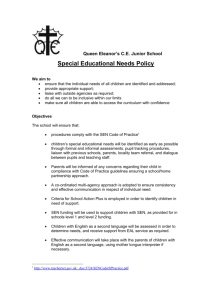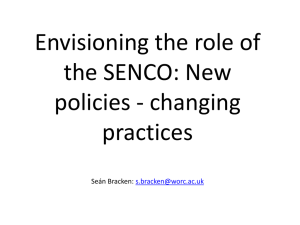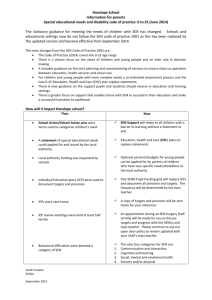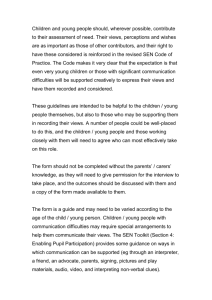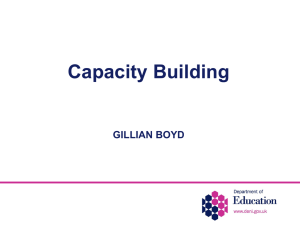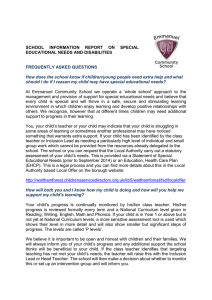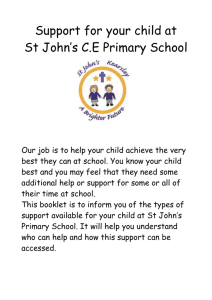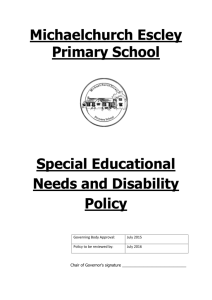St Philip Howard Catholic Primary School
advertisement
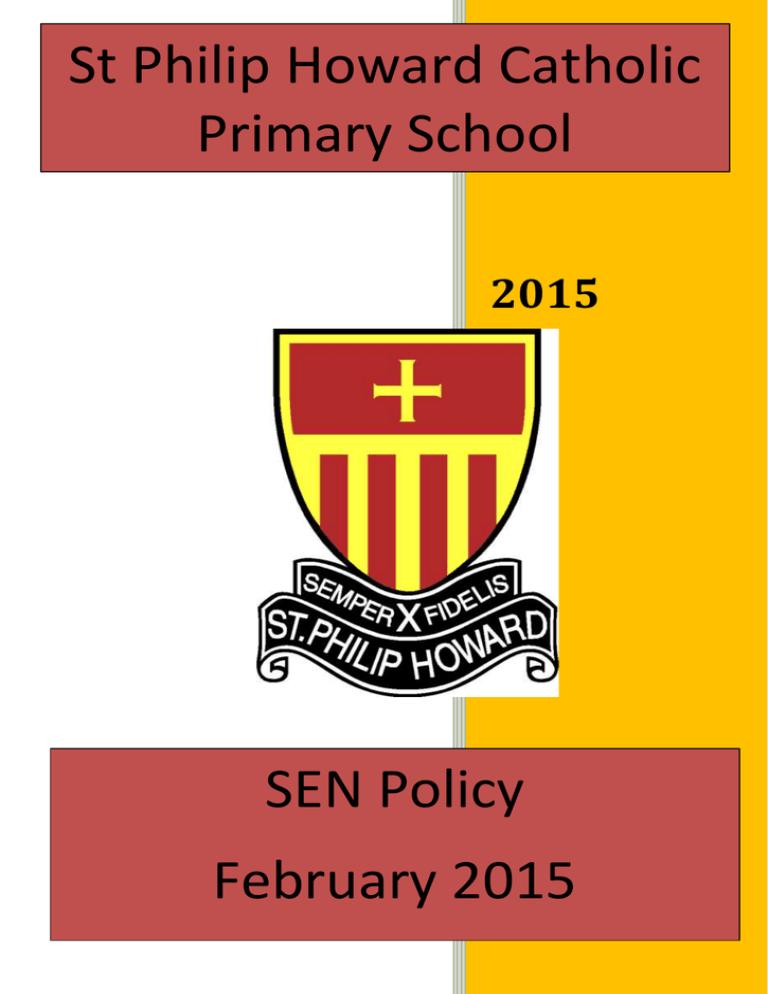
St Philip Howard Catholic Primary School 2015 SEN Policy February 2015 Contents Page Page Number Title 2 Definition of SEN 2 Definition of Disabled Children 3 Our Vision for our SEND Pupils 3 SEND Coordination The Role of the Teacher 4 SEND Coordination The Role of the SENCO 4 SEND Coordination The Role of the Headteacher 4 SEND Coordination The Role of the Governing Body 5 Admissions 5 Identifying SEN Broad Areas of Need 6 The Graduated Approach 7 Provision 8 Education, Health and Care Plans (EHCPs) 8 Medical Needs 9 Complaints 1 Definition of Special Needs This section comes directly from the Special Educational Needs and Disability Code of Practice: 0 to 25 years, Department for Education. A child or young person has SEN if they have a learning difficulty or disability which calls for special educational provision to be made for him or her. A child has a learning difficulty or disability if he or she: has a significantly greater difficulty in learning than the majority of children of the same age, or has a disability which prevents or hinders him or her from making use of educational facilities of a kind generally provided for children of the same age Special educational provision means: For children aged two or more, special educational provision is educational or training provision that is additional to or different from that made generally for other children of the same age, special educational provision means educational provision of any kind. Children must not be regarded as having a learning difficulty solely because the language or form of language of their home is different from the language in which they will be taught. Disabled Children This section comes directly from the Special Educational Needs and Disability Code of Practice: 0 to 25 years, Department for Education. Many children who have SEN may have a disability under the Equality Act 2010 – that is ‘…a physical or mental impairment which has a long-term and substantial adverse effect on their ability to carry out normal day-to-day activities’. ‘Long-term’ is defined as ‘a year or more’ and ‘substantial’ is defined as ‘more than minor or trivial’. This definition includes sensory impairments such as those affecting sight or hearing, and long-term health conditions such as asthma, diabetes, epilepsy, and cancer. Children with such conditions do not necessarily have SEN, but there is a significant overlap between disabled children and those with SEN. Where a disabled child requires special educational provision they will also be covered by the SEN definition. 2 Our Vision for our SEND Pupils We believe that every child is special and unique. Every child is an individual with particular strengths, abilities and needs. Some children will require extra help, in order to cope with specific learning difficulties. Our vision for our Special Needs Children is that they will have Confidence and that they will Achieve their Potential: SEND Co-ordination The Role of the Teacher Teachers are responsible for the progress and development of all the pupils in their class. The role of the teacher involves: Being aware of the school’s procedures for the identification and assessment of, and subsequent provision for pupils with SEND. Ensuring the SEN Policy is in place within their class. Collaborating with the SENCO to ensure SEN pupils are identified and are making progress – this could be through a Support Plan or an intervention. Planning for the SEN children in their class and differentiating lessons accordingly. Liaising with the parents of SEN children and keeping them informed of their progress (at least once a term). Liaising with Teaching Assistants about the SEN children in their class. 3 The Role of the SENCO The SEN Co-ordinator (SENCO) is Mrs Louise Field. She has completed the National Award in Special Educational Needs Co-ordination. She is also Assistant Headteacher and therefore on the Senior Leadership Team. The role of the SENCO involves: Working closely with the Headteacher and governing body, in determining the strategic development of SEN policy and provision in the school. Overseeing the day-to-day operation of the school’s SEN policy. Co-ordinating provision for children with SEN (this includes tracking and monitoring the impact of provision). Liaising with and advising colleagues. Contributing to the wider professional development of staff. Overseeing the records on all students with special educational needs and disabilities. Liaising with parents and carers. Liaising with external agencies. Liaising with the SEN governor and the governing body – report on the progress of children with SEN. Managing and deploying Teaching Assistants to match provision. The Role of the Headteacher The role of the Headteacher involves: Keeping the governing body informed about SEND in the school. Working closely with the SENCO in determining the strategic development of SEN policy and provision in the school. Ensuring appropriate resources are allocated for pupils with SEN from the delegated budget. Monitoring SEN provision. The Role of the Governing Body The SEN Governor is Mrs Maureen Sheehan. The SEN Governor is responsible for informing the Governing Body on all aspects of the school’s work with SEN pupils. The role of the governing body involves: Working closely with the SENCO in determining the strategic development of SEN policy and provision in the school. Ensuring that there is a SEND governor. Ensuring that funding meets the needs of pupils with SEN. Monitoring SEN provision. 4 Admissions SEND Students with a Statement or Education Healthcare Plan (EHCP) Applications received by the school from the local and neighbouring Boroughs are considered on an individual basis and considered against the following criteria: whether the school believes it can meet the identified requirements and needs of the child and; whether admitting the child might be incompatible with the provision of efficient education or the efficient use of resources for all other children. Where the application is for a student with a recognised disability, the school’s capacity to provide specialised and adapted facilities and resources will also be taken into account. SEND Students without a Statement or Education Healthcare Plan (EHCP) These arrangements are the same as all other students. Please see the school’s admission policy. Identifying SEN This section comes directly from the Special Educational Needs and Disability Code of Practice: 0 to 25 years, Department for Education. Broad areas of need These four broad areas give an overview of the range of needs identified for pupils. Communication and interaction Children and young people with speech, language and communication needs (SLCN) have difficulty in communicating with others. This may be because they have difficulty saying what they want to, understanding what is being said to them or they do not understand or use social rules of communication. The profile for every child with SLCN is different and their needs may change over time. They may have difficulty with one, some or all of the different aspects of speech, language or social communication at different times of their lives. Children and young people with ASD, including Asperger’s Syndrome and Autism, are likely to have particular difficulties with social interaction. They may also experience difficulties with language, communication and imagination, which can impact on how they relate to others. Cognition and learning Support for learning difficulties may be required when children and young people learn at a slower pace than their peers, even with appropriate differentiation. Learning difficulties cover a wide range of needs, including moderate learning difficulties (MLD), severe learning difficulties (SLD), where children are likely to need support in all areas of the curriculum and associated difficulties with mobility and communication, through to profound and multiple learning difficulties (PMLD), where children are likely to have severe and complex learning difficulties as well as a physical disability or sensory impairment. Specific learning difficulties (SpLD), affect one or more specific aspects of learning. This encompasses a range of conditions such as dyslexia, dyscalculia and dyspraxia. 5 Social, emotional and mental health difficulties Children and young people may experience a wide range of social and emotional difficulties which manifest themselves in many ways. These may include becoming withdrawn or isolated, as well as displaying challenging, disruptive or disturbing behaviour. These behaviours may reflect underlying mental health difficulties such as anxiety or depression, self-harming, substance misuse, eating disorders or physical symptoms that are medically unexplained. Other children and young people may have disorders such as attention deficit disorder, attention deficit hyperactive disorder or attachment disorder. Schools should have clear processes to support children, including how they will manage the effect of any disruptive behaviour so it does not adversely affect other pupils. The Department for Education publishes guidance on managing pupils’ mental health and behaviour difficulties in schools – see the References section under Chapter 6 for a link. Sensory and/or physical needs Some children and young people require special educational provision because they have a disability which prevents or hinders them from making use of the educational facilities generally provided. These difficulties can be age related and may fluctuate over time. Many children and young people with vision impairment (VI), hearing impairment (HI) or a multi-sensory impairment (MSI) will require specialist support and/or equipment to access their learning, or habilitation support. Children and young people with an MSI have a combination of vision and hearing difficulties. Information on how to provide services for deafblind children and young people is available through the Social Care for Deafblind Children and Adults guidance published by the Department of Health (see the References section under Chapter 6 for a link). Some children and young people with a physical disability (PD) require additional ongoing support and equipment to access all the opportunities available to their peers. The Graduated Approach Our School uses the Graduated Approach. This is a four-part cycle through which earlier decisions and actions are revisited, refined and revised with a growing understanding of the pupil’s needs and of what supports the pupil in making good progress and securing good outcomes. Step 1: Assess – The school will identify students who have special educational needs through the use of data, assessment, observations and liaison with previous educational settings and parents. The following triggers may cause a pupil to be identified: They are making significantly slower progress than that of their peers. Their rate of progress slows down or plateaus. Their behaviour is causing concern. A significant event has happened which is causing the child to have difficulties e.g. bullying or bereavement Step 2: Plan – The class teacher and SENCO will discuss the child’s needs. They will consider what action is required – e.g. an intervention or a Support Plan. On occasions a combination of strategies may be required. Parents will be made fully aware of the planned support and interventions. 6 Step 3: Do – The intervention and strategies will take place. During this time, the child is monitored closely to see if any improvements are being made. Step 4: Review – Support Plans are reviewed every term by the SENCO, class teacher, parents and child. If required, new targets are set. Interventions are monitored by the SENCO – children will only continue with the intervention if they are making good progress. Support will be adjusted if required. Provision For specific details of our current provision for special educational needs, please see our SEN School Offer document. Our support is based on the following model: For a few Statement / Education Health Care Plan 1:1 Support For some Targeted Provision Teacher and SENCO agree interventions and support to be put in place. For all High Quality Teaching High quality teaching, differentiated for individual pupils. High Quality Teaching High quality teaching, differentiated for individual pupils, is the first step in responding to pupils who may have SEN. Targeted Provision A range of interventions are available for pupils who need some additional support. We have Literacy, Numeracy and Emotional/Social Programmes. See our Local Offer for the full details of Provision offered. 7 Some children will also be on a Support Plan. Support Plans include: Likes and Dislikes of the child. Concerns that the child, parent(s) and school have. 3-4 short term targets that will address the above concerns. Strategies – what the child, parent(s) school will put in place to ensure the targets are met. Firstly, the Class Teacher will discuss the Support Plan with the pupil and then they meet the parents to and complete the Support Plan together. The Support Plans are written and reviewed three times a year – Autumn Term (October to February), Spring term (February to May), Summer Term (May to October). 1: 1 Support A few children may require Outside Agency Support. We work with the following: Applecroft Specific Learning Difficulties Base Educational Psychologist The Park ESC (Behaviour Support) Education Support Team for Medical Absence (ESTMA) Specialist Autism Teacher Communication Disorder Team Sensory and Physical Impairment Team School and Family Worker Counselling in Schools Child and Adolescent Mental Health Services (CAMHS) Speech and Language Therapist Occupational Therapist Social Services A few children with additional needs may require 1:1 support within lessons. This is often stated in their Educational Health Care Plan. Education Health and Care Plans Where, despite the school having taken relevant and purposeful action to identify, assess and meet the Special Educational Needs of the child, the child has not made expected progress, the school will consider requesting an Education, Health and Care needs assessment. This will be discussed with parents prior to an application. Medical Needs In line with The Children and Families Act 2014, we will make arrangements to support pupils with medical conditions. Some students with medical conditions may be disabled and where this is the case the school will comply with its duties under the Equality Act 2010. Some pupils with medical needs may also have SEN and may have a Statement or EHCP that outlines the provision they require. The SEN Code of Practice would be followed for these children. 8 Complaints In line with our SEN vision, we strive to do the best for all pupils and their parents/carers. If a parent/carer is not happy with the support their child is receiving, they should, in the first instance, contact the SENCO who will be happy to help. If they are still not happy, they should speak to Mrs Waugh, the Headteacher. Further information about the School’s complaints procedure is available on the school website: Other Important SEN Information: St Philip Howard Catholic School Information Report (School Offer) https://primarysiteprod.s3.amazonaws.com/uploads/54f99309eaca4c7981f281537accc950/e4e5/schooloffer_oct2014 .pdf Hertfordshire Local Offer http://directory.hertsdirect.org/kb5/hertfordshire/directory/localoffer.page Written by: Louise Field (SENCO) Signed by SENCO: Signed by Headteacher: Signed by Governors: Date to be reviewed: February 2016 9

